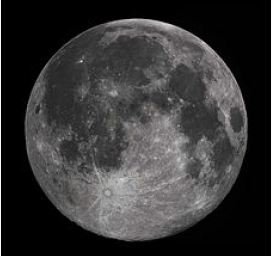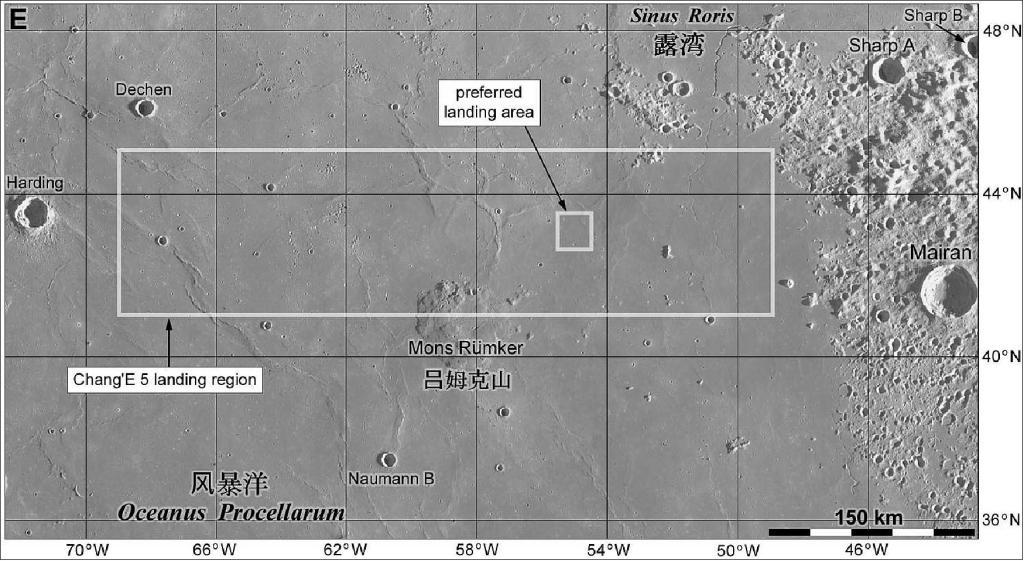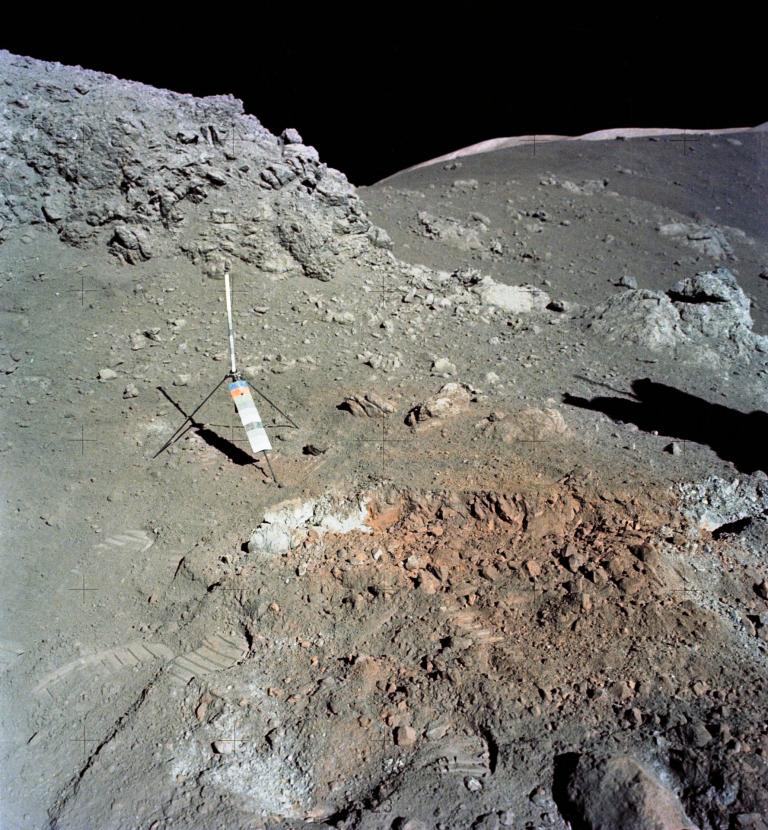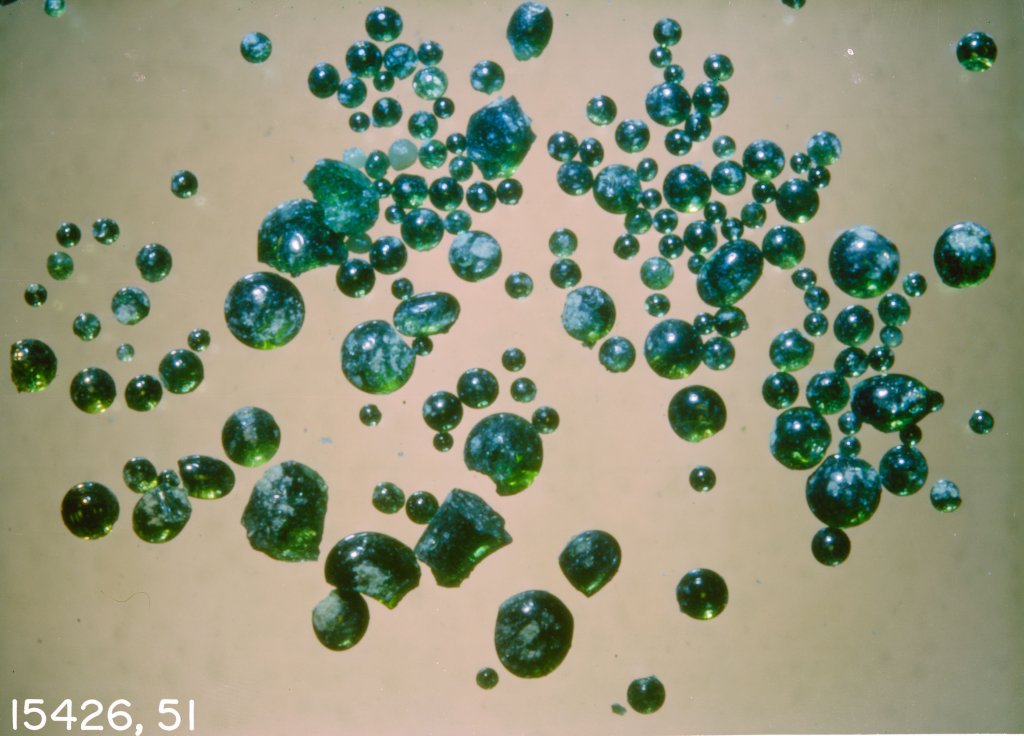Science
Moonrock 2021
In anticipation of China's Chang’e 5 returned sample analysis,
Duncan Lunan reviews what we have learned to date
from the Apollo Moonrock samples.
 The Moon as seen from the northern hemisphere © ESA
|
China’s Chang’e 5 spacecraft has returned the first samples to be brought back from the Moon since the Apollo missions and Soviet lunar landers of the 1970s. The spacecraft was launched on November 23rd, 2020, landed on December 1st, lifted off with samples and made the first automated docking in lunar orbit, before the return-to-Earth segment came back to land in Mongolia on December 16th. Both surface dust and a drill core were collected, although the latter was completed more rapidly than expected. It was intended to go down 2 metres, but ground-penetrating radar detected ‘several layers of slate’ below and drilling was terminated at 1 metre.(1) It’s not the first time this has happened: the Apollo 11 astronauts had difficulty even getting the flag to stand up, on Apollo 15 Dave Scott could only reach half the intended depth when drilling out a core and planting a heat-flow experiment, and NASA’s Insight probe has had to abandon its intended drilling experiment on Mars. Data from Chang’e 5 may shed more light on what the problems are.

Chang’e 5’s target and actual landing sites. © ESA.
Radar at ESA’s Kourou launch site provided tracking data
to the Chinese space agency throughout the mission. (2.)
 Chang’e 5. © NASA |
The proposed landing site (see above) was in northern Oceanus Procellarum, intended for the vicinity of Mons Rümker, a mountain which was photographed from orbit by Apollo 15 during the search for possible volcanic sites, but the landing was further east than intended.(2). It’s on the western limb of the Moon as seen from here, almost as far as possible from the sites in Mare Crisium sampled by the Soviets in the 1970s. Some sources say the landing was within sight of Mons Rümker, but as the lunar horizon is much closer than it is on Earth, the hills shown in the southwest of the surface panorama are presumably an outcrop, much nearer the touchdown site, simply labelled ‘Kipuka’ on the geological map – not a name but a description, defined on Wikipedia as ‘an area of land surrounded by one or more younger lava flows’. Further east of the lander, 40 km away, is Rima Sharp, a sinuous rille like the one visited by Apollo 15, which is thought to be a collapsed lava tube. The importance of the Chang’e 5 site is that it is believed to be much younger than any of the ones sampled so far - a complete turnaround from the objectives of the Apollo missions.
In the planning of the Moon landings, the big hope was that they would answer the questions about the origin of the Moon, and provide samples from the earliest history of the Solar System. The idea that the Moon had split off from the proto-Earth had long been discarded as dynamically impossible, but there was ongoing argument about whether the Moon had formed along with the Earth, already in orbit, or had formed separately and been captured. A separate argument concerned whether the visible lunar features were formed by volcanic activity (favoured mostly by British and European experts) or by impacts (favoured in the USA). The US Surveyor landers and the Soviet Luna ones had indicated that they were on surfaces resembling basalt, but those could be either volcanic or impact melts. Both sides found features to support their views in the photography by Ranger probes and Lunar Orbiters.
The samples brought back by the early Apollo missions dashed hopes of swift answers to any of those questions. The dark plains of the lunar maria were indeed basalts, but their ages were typically on the order of 3.5 billion years. The only rocks dating back to near the origin of the Solar System, 4.6 billion years ago, were tiny fragments embedded in breccias (composite rocks) and probably meteoritic. As probes to the planets found evidence that cratering in the Solar System was far more widespread than expected, the idea arose that the inner planets, and possibly the whole system, had been swept by an intense wave of bombardment which had melted the entire lunar crust, between 4.2 and 3.9 billion years ago; followed a few hundred million years later by an unexplained phase in which the larger impact basins, at least on the side of the Moon facing Earth, were filled by volcanic upwelling of basalt, whose darker hue was due to titanium compounds rather than the aluminium-dominated anorthosite of the original lunar crust. Meanwhile, as the later Apollo missions brought back highland rocks dating to 4.4 by before present, and even they were dry like the mare basalts, it seemed that the crucial difference from Earth rocks was the complete absence of volatiles – compounds of hydrogen, carbon and nitrogen which had apparently been driven out of moonrock by a much larger collision, very early in Solar System history, between the proto-Earth (‘Gaia’) and a Mars-sized body named Theia. Argument continues over whether there was one impactor or several, whether the debris coalescing around the Earth formed one Moon or several, and whether the lunar Farside has been resurfaced by a single impact which formed the huge Aitken Basin tangential to the south pole, but the general model now starts with very big impacts, then medium-sized ones, then volcanic outflows, then smaller impacts.
More Recent Analyses
But has there been ongoing small-scale volcanic activity, extending down to the present? Argument continues, and until comparatively recently, has been frustrated by the fact that most of the returned material had never been examined. Before the Moon landings NASA created a Lunar Receiving Laboratory adjacent to the Johnson Space Centre in Houston, followed in 1979 by the much larger Lunar Sample Laboratory Facility, but after the notorious Senator William Proxmire gave the analysis of moonrock one of his ‘Golden Fleece’ awards for what he considered to be the waste of government money on useless science, both Senate and Congress refused to allocate money for further research, for many years thereafter. When I visited the Laboratory in 1984, there were only four people from two university teams at work, and the rest of the building was empty. The position has improved since and by now most of the returned moonrock has had at least preliminary study, though some is being preserved for future researchers with more advanced techniques.
 Orange soil from Shorty Crater © NASA |
One of the big revisions to result from that concerns water within the Moon. One of the let-downs of the last Apollo mission was that the ‘orange soil’ brought back from Shorty Crater (see left) turned out not to be volcanic, but impact glass beads. In June 1973, I organised a talk by a member of the analysis team, who remained resentful that her summer vacation had been postponed to give priority to those samples, and said, in so many words, “The astronauts are such clowns that they couldn’t tell impact glass from volcanic sulphur”. Only recently has it emerged that while the beads had indeed been excavated by a comparatively recent impact, they had formed in a much bigger, deeper one, from strata which contained water. A similar result was obtained with the green beads returned by Apollo 15 (see below), and as a result the ‘rusty rock’ returned by Apollo 14 has been re-examined, turning out not to be a case of laboratory contamination as previously supposed.
 Green beads in an Apollo 15 sample. © NASA |
We are not back to the Victorian belief that there would be water and breathable air within the Moon. (For some splendid examples, see Mike Ashley, ed., Moonrise: The Golden Age of Lunar Adventures, British Library, 2018), nor to the honeycombed lunar interior described by Edgar Rice Burroughs in his lunar novels. The last advocate of that idea, as far as I know, was the Arran-based astronomer V.A. Firsoff in his Strange World of the Moon (Hutchinson, 1967). Firsoff was wrong in some of his conjectures – he thought Jupiter’s Great Red Spot was a failed satellite, composed of ices – but he was right about ice at the poles of Mercury (detected by radar from Arecibo, confirmed by the Messenger orbiter), and about a giant tectonic grid of fissures centred on the sub-Earth region of the lunar Nearside (discovered by the GRAIL probes in 2012). And even if he’s probably wrong about lakes or even seas beneath the lunar surface, they have now been discovered below the surfaces of Europa, Ganymede, Enceladus, Pluto, and possibly even Venus, Titan and Io. So I wouldn’t bet that the Moon has no such surprises for us – which brings us back to Chang’e 5.
The mare basalt on which Chang’e 5 has landed is estimated to be only 1.2 billion years old, more than a billion years younger than any site sampled hitherto. At the very least, the surface sample and the drill core which have been returned should tell us a great deal about conditions on and within the Moon at that time. Without going into detail, Wikipedia says that up to 27 unresolved questions about that epoch may be answered. And if it goes the way all previous lunar and planetary missions have gone, it will be no surprise if the real surprise turns out to be information that we didn’t expect at all!
Duncan Lunan
Duncan Lunan has: published 10 books on astronomy, spaceflight and SF and contributed to 36 more; had 42 published SF stories and; written over 1,600 articles, including a monthly astronomy column ‘The Sky Above You’. He has written numerous SF reviews for Interzone and Shoreline of Infinity, as well as currently non-fiction (in the past also fiction) for SF² Concatenation. He built the first astronomically aligned stone circle in Britain for over 3,000 years (recreated at a new site in 2019), and was a curator of Airdrie Public Observatory for over 18 years. Details of his books and other work are on his website, www.duncanlunan.com, and he can be contacted there or directly at duncanlunan [-at-] gmail [-dot-] com.
References
1) Jones, A. (2020) China says it's open to sharing moon rocks as Chang'e 5 samples head to the lab. Space.Com Online, 23rd December.
2) Anon, (undated) Chang'e-5 (China's Lunar Sample Return Mission) / CE-5’, eo Portal Directory, ESA, online.
[Up: Article Index | Home Page: Science Fact & Fiction Concatenation | Recent Site Additions]
[Most recent Seasonal Science Fiction News]
[Convention Reviews Index | Top Science Fiction Films | Science Fiction Books]
[Science Fiction Non-Fiction & Popular Science Books]